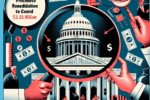Washington, D.C. — As Congress grapples with significant budgetary challenges, House Republicans find themselves navigating a complex landscape of competing priorities. The GOP is under pressure to formulate a spending plan that not only addresses a staggering $1.5 trillion in proposed cuts but also appeases an increasingly divergent party base.
With the potential for major reductions in social safety net programs, tensions among party members are rising. Some Republicans advocate for sweeping tax cuts, while others insist on protecting crucial social services. This internal struggle reflects a broader unease about the party’s direction amid upcoming elections.
House Speaker Mike Johnson faces the daunting task of balancing these demands while maintaining party unity. His leadership is further complicated by a resistance within the House that makes it challenging to push through any cohesive strategy. Lawmakers are wary of alienating constituents who depend on benefits such as Social Security and Medicare, with some Democrats seizing the opportunity to highlight these concerns.
Recent polling indicates that a significant portion of voters opposes cuts to these programs, putting pressure on vulnerable Republicans. Many incumbents are in districts where the electorate relies heavily on social support systems, creating a precarious situation for those contemplating the proposed cuts.
The Democratic Party has been vocal in its criticism, launching campaigns aimed at spotlighting Republican plans that could threaten vital programs. These efforts are part of a broader strategy to rally public support and sway opinion ahead of the 2024 elections, branding opponents as hostile to the interests of many American families.
As Johnson and House leaders strive to forge a path forward, they must also consider the implications of their decisions on their political futures. Navigating the choppy waters of budgetary reform requires a delicate equilibrium between fiscal responsibility and the needs of the electorate.
In light of these pressures, the GOP’s strategic outlook remains uncertain. The party’s ability to meet its legislative goals while maintaining a united front will be closely monitored as key deadlines loom. The upcoming weeks will likely reveal whether the Republicans can harness their internal diversity to create a viable funding plan that aligns with their overarching goals and appeal to their constituents.
As the political landscape evolves, the delicate balance of power within the Republican Party will face critical tests, potentially reshaping the contours of American governance for years to come.










